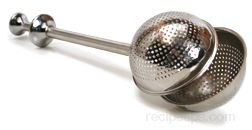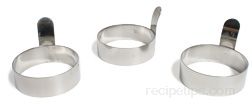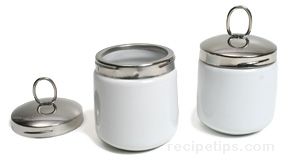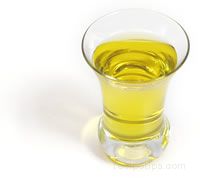Eggshell and Yolk Color | Egg Size | Egg Grading | Egg Freshness
When shopping for food items, it is often beneficial to learn something about the products before you purchase them. Whether it is quality issues or particular characteristics unique to an individual food product, gaining a thorough knowledge of the foods that you buy will help you make informed choices on which foods are best for you and your family. Becoming educated about food can take the mystery out of many of the foods that you shop for regularly.
Eggs are among those foods that many people know very little about. Many of us enjoy eggs for breakfast and use them in cooking and baking; however, most of us are unaware of the reasons why eggs come in different colors or why some eggs are larger than others or what criteria are used for determining quality. The following information (and the information provided in all of the other articles under "Eggs") will hopefully provide you with useful information concerning a food item that most of us know very little about.
Eggshell and Yolk Color
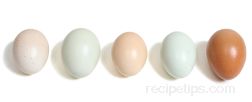
When you are shopping for eggs, you may notice that the eggshell color may differ from one batch of eggs to the next. You may also notice that when using eggs, the color of the yolk may be different from time to time. An eggshell color other than the usual white and a yolk that is not a perfect golden yellow do not indicate that there is a problem with an egg or that there will be any difference in the flavor or nutritional value.
The shell color of a chicken egg is determined by the breed of the chicken. Even though there is no difference between white and brown eggs other than the shell color, brown eggs are slightly more expensive because the breeds that lay them are larger and require additional food. The extra cost of the additional feed results in extra cost for the consumer.
The color of the egg yolk is usually determined by the hen's diet. Feed produced with yellow or orange ingredients results in the usual golden color of the yolk. Lighter colored feed ingredients result in a yolk color that is paler and lighter. Natural ingredients with yellow or orange pigments may be mixed with the feed to brighten the yolk color, but the addition of artificial pigments is not allowed.
A blood spot may be found on the egg yolk, but this is a rare occurrence. Most eggs with blood spots are removed during processing, but a few may slip through and reach the consumer. The blood spot does not affect the quality or flavor of the egg, and it actually indicates that the egg is very fresh because the blood spot tends to get diluted as the egg ages.
Egg Size

Eggs are available in several sizes:
- Peewee
- Small
- Medium
- Large
- Extra Large
- Jumbo
The most common sizes that are available to consumers are medium, large, and extra large.
|
The size of the egg is determined by several factors including:
|
|
The "per dozen net weight" (in ounces) is the standard that is used to classify egg sizes.
|
|
Many recipes that include eggs as an ingredient specify the use of large eggs; therefore, if the eggs that are available to you are smaller or larger, it is beneficial to know the egg size equivalents. Using the following guidelines, you should be able to achieve a quantity that will work well for most recipes.
|
|
For a more precise measure, use the following instruction:
|
Egg Grading
The grade of an egg refers to the quality of the egg. It has nothing to do with the size. The grade is determined by an inspection of the egg. The interior is inspected as well as the exterior. In order to inspect the contents of the egg, a procedure called candling is used. Candling is the process of passing eggs in front of bright lights to reveal the contents inside the shell. Before the development of electric lighting, eggs were passed in front of candle flames, hence the name, candling.
Criteria Used for Determining Egg Quality
Eggshell Integrity
The eggshell is inspected for shape and abnormalities. The shell must be in good shape, free of cracks, stains, rough spots, or ridges.


Air Cell Size
Higher grade eggs have a small air cell, indicating that the egg is very fresh. The size of the air cell increases as the egg ages.
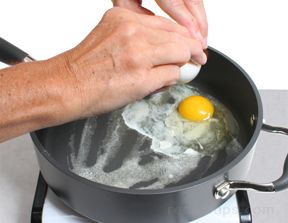
Appearance after Breaking
Quality is also determined by the size of the area that the contents cover after the egg is broken. The contents of a higher quality egg cover a smaller area than a lower quality egg. Low quality eggs tend to spread out and have a runnier appearance.
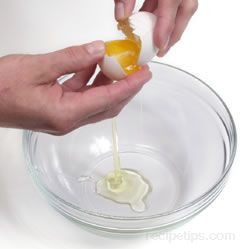
Albumen
The proportion of thick egg white compared to the thin egg white is greater in a high grade egg. The chalaza should be very noticeable in a high grade egg.

Yolk Quality
High grade eggs contain yolks that are plump and round. The yolks in lower grade eggs appear flattened and limp.
Blood Spots
If egg yolks contain blood spots, the eggs are typically removed during the candling process, although one may slip through occasionally and reach the consumer. Blood spots do not affect the quality or flavor of the egg and actually are an indication that an egg is very fresh. Blood spots tend to become diluted as the egg ages.
USDA Classifications for Eggs
| Grade AA | Grade AA is the highest quality possible. Because of their quality, grade AA eggs can be used for any purpose but are especially useful for cooking methods in which the egg is cooked in the shell. |
| Grade A | The quality of Grade A eggs is slightly less than that of a Grade AA, but most consumers cannot tell the difference. The air cell is slightly larger, the proportion of thick to thin albumen is not as great, and the contents may spread out a bit more once the egg is cracked open. Grade A and Grade AA are the designations that consumers will most often find in food stores. |
| Grade B | The decrease in quality of Grade B eggs is quite noticeable. The shell may be discolored, blemished, and oddly shaped. The air cell may be very large and the contents runnier, but the nutritional value is the same as higher grades and the flavor is similar. Most grade B eggs are used by commercial operations that produce egg products and some are used by commercial bakers. |
Methods of Designating the Grade on Egg Cartons

USDA "Grade A" Seal
Shown in the Upper Right Corner
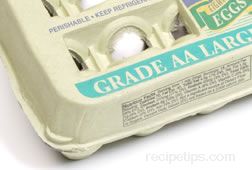
USDA "Grade AA" Eggs
Egg Freshness
The cartons containing eggs that have been inspected by the USDA (United States Department of Agriculture) are stamped with a date indicating the last day that the eggs can be legally sold. This sell-by-date is no more than 30 days beyond the date the eggs were packed. Eggs are usually packed within one week of being laid, but it is possible that the eggs may be packed as long as 30 days after being laid, which is within USDA regulations.
The freshness of an egg is not only determined by the date when the egg was laid, but also by the way the egg has been stored. Proper handling and storage is, perhaps, the most important aspect when determining freshness. If a freshly laid egg is left at room temperature for a full day, it will not be as fresh as a week old egg that has been refrigerated between 33° and 40°F from the time it was laid.
The packing date is a 3-digit code that is stamped on the carton near the sell-by-date. Every day of the year is given a number beginning with "1" for January 1 and "365" for December 31. In the illustration shown, the number 105 stamped on the carton shown indicates that the eggs were packed on April 15, the 105th day of the year. (The number to the left of 105 is a code number used by the packing company.) Eggs can be sold up to a month after the packing date. If eggs are properly stored in the refrigerator, they are usually safe to eat up to a month after the sell-by-date. A general rule to follow is that any egg that looks or smells odd should not be used.










